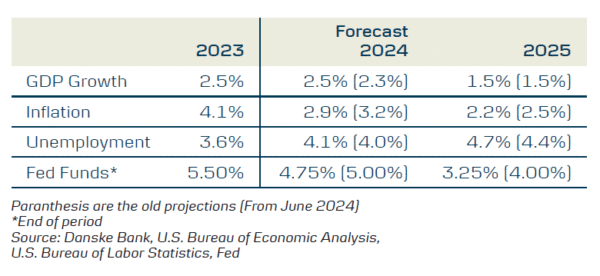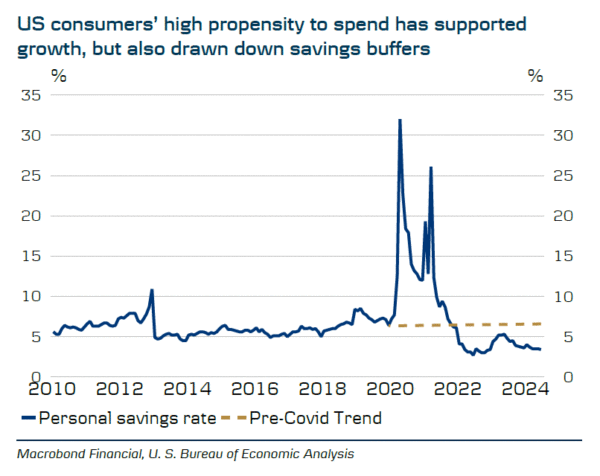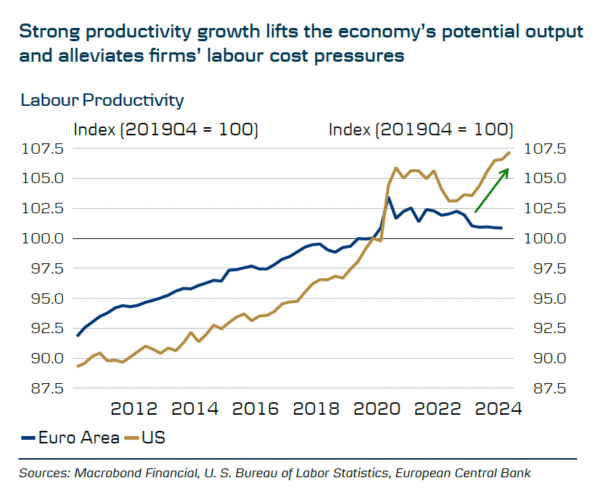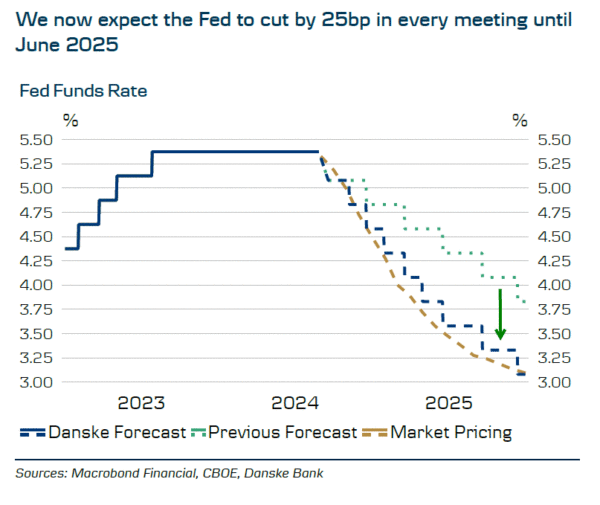- Economic growth is slowing mostly in line with our expectations, but we think recession risks remain low. We make only marginal adjustments to our forecast profile and see 2024 GDP growth at 2.5% (from 2.3%) and 2025 at 1.5% (unchanged).
- Potential output continues to grow at a brisk pace, supported by increases in labour supply, solid productivity growth and fiscal policy driven demand for manufacturing investments.
- Risks to the outlook remain somewhat skewed to the downside. The current low savings rate indicates that consumers’ buffers remain weak. Slow monetary policy pass-through and high share of fixed rate mortgages suggest that rate cuts will not provide a rapid boost to economic growth, if the outlook deteriorates faster than we expect.
- Inflation forecasts have been adjusted modestly lower. We see headline inflation averaging 2.9% in 2024 (from 3.2%) and 2.2% in 2025 (from 2.5%) and core inflation at 3.3% in 2024 (from 3.4%) and 2.4% in 2025 (from 2.6%). We now expect the Fed to cut interest rates by 25bp at every meeting from September until June 2025 (prev. only every other meeting from September), followed by two final cuts in H2 2025 (terminal rate 3.00-3.25%; prev. 3.75-4.00%).
Economic growth slowed down during the first half of 2024, partly due to negative contribution from net exports but also slowing private consumption and investment growth. Labour market conditions have also cooled faster than expected, but mostly as a result of rapidly growing labour force, as number of layoffs is still low. Overall, we think the US economy remains on a solid footing and the soft landing is still in sight.
In contrast to some European economies, US consumers’ savings rates have remained low throughout the post-pandemic period. Solid labour markets and relatively upbeat consumer sentiment have supported continuous growth in real spending volumes. However, if wage growth cools and concerns around rising unemployment start to set in, consumers’ savings buffers remain weak. Latest retail sales and sentiment indicators suggest that for now, nominal spending growth has remained brisk and optimism about future outlook has risen, but also that consumers are getting increasingly worried about their current economic situation.
Investment growth has also slowed down as tight monetary policy bites into businesses’ expansion plans. Uncertainty about the fiscal policy outlook and especially the future of IRA subsidies might have delayed some investment plans as well. However, we expect overall fiscal policy stance to remain expansionary over the coming years, irrespective of the election outcome. Kamala Harris would likely follow on Biden administration’s footsteps, preserving the IRA as intended while opting for corporate tax hikes to fund the growing deficits. On the other hand, while Donald Trump’s plans for scrapping the IRA and sharply increasing tariffs on imports would have disrupting effects on growth in the near-term, he would also provide support via extending the TCJA income tax cuts from his first term while further reducing corporate taxes. We do not foresee either candidate sharply reducing public budget deficits in the near-term but see higher risk of unsustainable debt dynamics in the case of Trump’s victory.
Inflation has slowed down over the summer, and since our June edition, especially the broader services price pressures have eased noticeably. In addition to easing labour shortages, strong labour productivity growth has continued to alleviate firms’ cost pressures. Rising productivity and labour supply mean that US economy’s potential growth remains elevated. We think that the risk of an outright recession remains low, but still see growth slowing below potential over the coming quarters.
As labour markets are now longer overheated and both realized and expected inflation are cooling, we now expect the Fed to cut rates by 25bp in every meeting from September to June 2025, followed by two final 25bp cuts in H2 2025. As such, we see the nominal terminal policy rate at 3.00-3.25% (prev. 3.75- 4.00%) by the end of 2025.
Expectation of rapid rate cuts has already contributed to easing financial conditions in the markets. On the other hand, slow monetary policy pass-through means that the boost to growth will come with a lengthy delay. 95% of US mortgages are locked into fixed interest rates, and even though mortgage rates have already started to decline, demand for new loans remains low. As recession risks remain low in our view and as FOMC participants have communicated preference for a gradual easing cycle, we do not agree with markets’ speculation about 50bp cuts. But even so, we now think the Fed will cut rates noticeably faster than the ECB, which reflects expectation of continuous growth in the US economy’s productive capacity. The lack of similar slack in the euro area will not, in our view, allow the ECB to cut rates as quickly as the Fed.
















